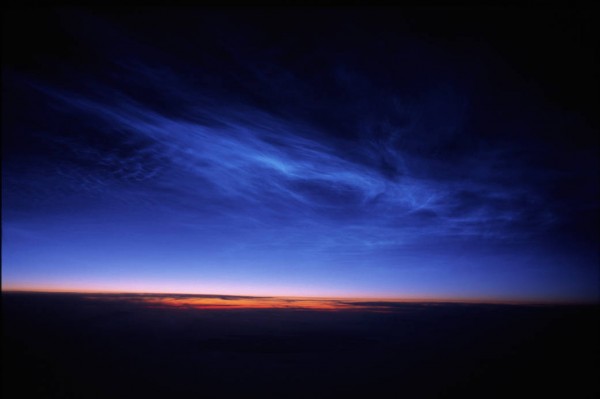By Ana Verayo, | December 05, 2016

Noctilucent Clouds taken from 36,000 feet above the South of Nunivak Island, Alaska on June 20, 2006. (John Boardman/NASA)
During this time of the year, some wispy, glowing blue clouds appear over the Antarctic region, shining in the night skies. These high altitude clouds are apparently caused by meteorite debris and methane, a powerful greenhouse gas found in the atmosphere.
Like Us on Facebook
These blue clouds are known as "noctilucent clouds." NASA's Aeronomy of Ice in the Mesosphere (AIM) spacecraft has revealed new imagery from the Antarctic, hinting that these clouds appeared earlier this year due to the massive amount of methane and greenhouse gasses in the Earth's atmosphere.
NASA scientists say that these blue noctilucent clouds first appeared this year on November 17, which is the earliest date of its appearance recorded yet in the Antarctic.
What are noctilucent clouds and why do they appear? NASA's AIM studied these cloud phenomena to gain a better understanding of the planet's mesosphere and its connection to the other layers of the atmosphere. The mesosphere in the Antarctic region is most humid during the summer, as water vapor drifts up from lower altitudes. During this time, the mesosphere also drops to minus 210 degrees during seasonal air flow patterns and changing seasons.
Scientists say that noctilucent clouds are appearing earlier than usual and are now scattered over larger areas. According to NASA AIM principal investigator, James Russell, there is a growing abundance of methane in Earth's atmosphere that can provide more water vapor to form ice crystals, which are the main components of these blue clouds.
NASA revealed that when temperatures suddenly change like transitioning from winter to summer, the lower atmosphere of the Antarctic spark a complex series of reactions around the entire atmosphere, and this results in an earlier than usual noctilucent cloud season.
NASA AIM data also reveals how changes in one part of the atmosphere can also affect other distant regions in the atmosphere. Scientists call this "atmospheric teleconnection."
-
Use of Coronavirus Pandemic Drones Raises Privacy Concerns: Drones Spread Fear, Local Officials Say

-
Coronavirus Hampers The Delivery Of Lockheed Martin F-35 Stealth Fighters For 2020

-
Instagram Speeds Up Plans to Add Account Memorialization Feature Due to COVID-19 Deaths

-
NASA: Perseverance Plans to Bring 'Mars Rock' to Earth in 2031

-
600 Dead And 3,000 In The Hospital as Iranians Believed Drinking High-Concentrations of Alcohol Can Cure The Coronavirus

-
600 Dead And 3,000 In The Hospital as Iranians Believed Drinking High-Concentrations of Alcohol Can Cure The Coronavirus

-
COVID-19: Doctors, Nurses Use Virtual Reality to Learn New Skills in Treating Coronavirus Patients







